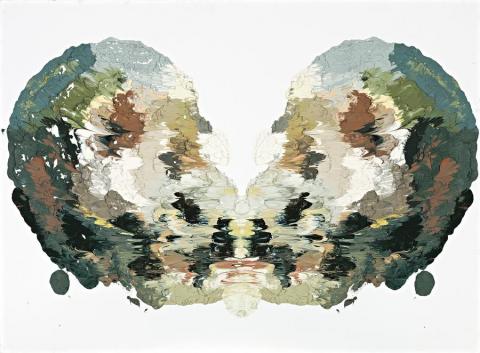INSIGNIA 3, 2007
BEN QUILTY
oil on canvas
140.0 x 190.0 cm
signed, dated and inscribed with title verso: ‘Insignia’ Ben Quilty ‘07
Jan Murphy Gallery, Brisbane (label attached verso)
Private collection, Sydney
The Rorschach test reached the zenith of its popularity in the 1960s where its ambiguity of form was thought to reveal hidden emotions and internal conflicts. The concept that the interpretation of enigmatic patterns may reveal inner traits had its roots well within art history; Rorschach in effect systemized an idea explored by Leonardo da Vinci and Botticelli in their studies of pattern ambiguity and human perception of order.
In contemporary culture, the inkblot has evolved into a meme, communicating an idea of the unknown self revealed through pattern. What we see in the Rorschach is a harbinger of our own secret desires and fears. This idea holds enormous interest for Ben Quilty who has long been interested in how the visual can trigger sensation. As Quilty describes, 'Most of my work investigates the relationship between a luscious surface and the darker and more confronting nature of the overall image. I enjoy the theatrics of forcing the viewer to move back from the enticing surface to see the more figurative imagery hidden in the paint. My application of paint is quick and violent, and the imagery is often connected to the uneasy feeling of facing an uncertain future or the indulgent glorification of decline.'1
Constantly evolving, Ben Quilty's manifestations of the inkblot are also explorations of destruction. Both the subject, here a pair of skulls, and the annihilating act of pressing two canvasses together to make the work are gestures towards mortality. The final act of the painting's creation in effect obliterates the gestural quality for which Quilty's work is so celebrated. Describing the process, Quilty noted that he's quashed the carefully made image against another canvas and destroyed the original. The act of destroying the first image creates a more beautiful Rorschach 'butterfly.'2
This act of obliteration which conceals or obscures the subject ultimately produces a work of greater complexity and beauty. It is this ambiguity which is so strangely appealing to the human mind. Of the Rorschach works, Nick Mitzevich observed that they 'literally require their subjects to look at themselves, be they Jimmy Barnes of Cold Chisel fame, a Death Metal skull entwined by serpents (a memento mori for our times), Captain James Cook, or the skull overlain with the memory of the 'Bedford Downs' massacre in the Kimberley. These images look to the histories that figure in school history books and those that do not, and to the narratives that run through our popular culture. They look to stories that tell us about our nation and about ourselves. And, in doing so, they rework the portrait so that we see beyond the surface to a darker self.'3
1. The artist in conversation with Lisa Slade, Ben Quilty Live interpretive guide, The University of Queensland Art Museum, Brisbane, 2009, p. 3
2. Ibid.
3. Nick Mitzevich in Slade, L., Ben Quilty, The University of Queensland Art Museum, Brisbane, 2009, p. 11
MERRYN SCHRIEVER
